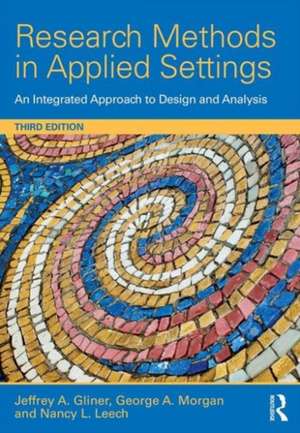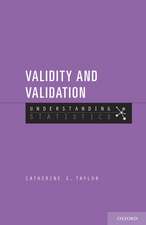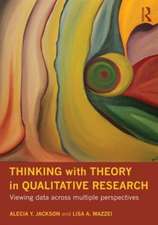Research Methods in Applied Settings: An Integrated Approach to Design and Analysis, Third Edition
Autor Jeffrey A. Gliner, George A. Morgan, Nancy L. Leechen Limba Engleză Hardback – 10 aug 2016
Adopters applaud the book’s clarity and applied interdependent approach to research. The book emphasizes five research approaches: randomized experimental, quasi-experimental, comparative, associational, and descriptive. These five approaches lead to three kinds of research designs which lead to three groups of statistics with the same names. This consistent framework increases comprehension while avoiding confusion caused by inconsistent terminology. Numerous examples, diagrams, tables, key terms, key distinctions, summaries, applied problems, interpretation questions, and suggested readings further promote understanding.
This extensively revised edition features:
- More examples from published research articles to help readers better understand the research process.
- New Research in the Real World boxes that highlight actual research projects from various disciplines.
- Defined key terms in the margins and interpretation questions that help readers review the material.
- More detailed explanations of key concepts including reliability, validity, estimation, ethical and bias concerns, data security and assumptions, power analysis , and multiple and logistic regression.
- New sections on mediation and moderation analysis to address the latest techniques.
- More coverage of quasi-experimental design and qualitative research to reflect changing practices.
- A new appendix on how to write about results using APA guidelines to help new researchers.
- Online resources available at www.routledge.com/9781138852976 that provide instructors with PowerPoints, test questions, critical thinking exercises, a conversion guide, and answers to all of the book’s problems and questions. Students will find learning objectives, annotated links to further readings and key concepts, and key terms with links to definitions.
Preț: 840.48 lei
Preț vechi: 923.61 lei
-9% Nou
Puncte Express: 1261
Preț estimativ în valută:
160.84€ • 174.65$ • 135.11£
160.84€ • 174.65$ • 135.11£
Carte disponibilă
Livrare economică 02-16 aprilie
Livrare express 18-22 martie pentru 61.22 lei
Preluare comenzi: 021 569.72.76
Specificații
ISBN-13: 9781138852976
ISBN-10: 113885297X
Pagini: 620
Ilustrații: 58
Dimensiuni: 178 x 254 x 38 mm
Greutate: 1.28 kg
Ediția:Revised
Editura: Taylor & Francis
Colecția Routledge
Locul publicării:Oxford, United Kingdom
ISBN-10: 113885297X
Pagini: 620
Ilustrații: 58
Dimensiuni: 178 x 254 x 38 mm
Greutate: 1.28 kg
Ediția:Revised
Editura: Taylor & Francis
Colecția Routledge
Locul publicării:Oxford, United Kingdom
Public țintă
ProfessionalCuprins
Part I. Introductory Chapters 1. Definitions, Purposes, and Dimensions of Research 2. Planning a Quantitative Research Project Part II: Quantitative Research Approaches, Questions, and Designs 3. Variables, Research Questions, and Hypotheses 4. Research Approaches 5. Randomized Experimental and Quasi-Experimental Designs 6. Single-Subject Designs 7. Non-experimental Approaches/Designs 8. Internal Validity Part III: Sampling, Measurement and Data Collection 9. Sampling and Introduction to External Validity 10. Measurement and Descriptive Statistics 11. Measurement Reliability 12. Measurement Validity 13. Types of Data Collection Techniques 14. Ethical Issues in Conducting the Study 15. Practical Issues in Data Collection and Coding Part IV: Data Analysis and Interpretation 16. Making Inferences from Sample Data I: The Null Hypothesis Significance Testing Approach 17. Making Inferences From Sample Data II: The Evidence-Based Approach 18. General Design Classifications for Selection of Difference Statistical Methods 19. Selection of Appropriate Statistical Methods: Integration of Design and Analysis 20. Data Analysis and Interpretation – Basic Difference Questions 21. Analysis and Interpretation of Basic Associational Research Questions 22. Analysis and Interpretation of Complex Research Questions Part V: Evaluating and Writing Research Reports 23. Evaluating Research Validity: Part I 24. Evaluating Research Validity: Part II 25. Evaluating Research for Evidence-Based Practice 26. Writing the Research Report
Notă biografică
Jeffrey A. Gliner is Professor Emeritus of Occupational Therapy at Colorado State University. He taught graduate level research methods, statistics, and program evaluation courses to masters and doctoral level students for more than 20 years.
George A. Morgan is a Professor Emeritus of Education and Human Development at Colorado State University. He taught research methods and applied statistics to graduate students in several departments at Colorado State. In addition to writing textbooks on SPSS and research methods, he currently advises students on their dissertation research.
Nancy L. Leech is a Professor at the University of Colorado Denver. Dr. Leech is currently teaching graduate level courses in research, statistics, and measurement.
George A. Morgan is a Professor Emeritus of Education and Human Development at Colorado State University. He taught research methods and applied statistics to graduate students in several departments at Colorado State. In addition to writing textbooks on SPSS and research methods, he currently advises students on their dissertation research.
Nancy L. Leech is a Professor at the University of Colorado Denver. Dr. Leech is currently teaching graduate level courses in research, statistics, and measurement.
Recenzii
"Gliner, Morgan, and Leech have built upon and enhanced their previous work in designing this clear and comprehensive 3rd edition, perfect for a quantitative research design course, or as a go-to text for the quantitatively-focused researcher." —Erica Eckert, Kent State University, USA
"We have used this textbook for a number of years. It is clear, well-organized, and written at a level suited to doctoral students who do applied work using a variety of research methodologies. The latest edition improves upon an already good book by adding sections from research articles that exemplify points the authors are making, tables and diagrams for visual learners, and references to effect size and power that reinforce the need for consideration of the research design from multiple perspectives. Our students do a good job of writing a research proposal using the information from this book." —Kathy Green, University of Denver, USA
"This third edition is a comprehensive and well-written book for graduate students and researchers doing research in education and other applied areas. The book provides not only an in-depth discussion of research methods concepts, but also a lot of real life examples for illustration. It is an excellent reference source for anyone doing research." —Michael C. W. Yip, The Hong Kong Institute of Education, Hong Kong
"This is an indispensable text for students of applied research and even though I have many years of experience myself, I find it very helpful in doing my own research projects and teaching research to graduate students. It sets out key messages about how to do research properly, and in this 3rd edition bases much of its advice on practical case studies." —Paul Kiff, The Research Academy, UK
"This is an excellent textbook for any education or social science course on quantitative methods. The authors break down the elements of the research process into easily digestible segments that use examples from published research studies to demonstrate each step. This is a must for faculty introducing graduate students to quantitative methods and also as an easy to use reference for the experienced researcher." —Mark Kretovics, Kent State University, USA
"We have used this textbook for a number of years. It is clear, well-organized, and written at a level suited to doctoral students who do applied work using a variety of research methodologies. The latest edition improves upon an already good book by adding sections from research articles that exemplify points the authors are making, tables and diagrams for visual learners, and references to effect size and power that reinforce the need for consideration of the research design from multiple perspectives. Our students do a good job of writing a research proposal using the information from this book." —Kathy Green, University of Denver, USA
"This third edition is a comprehensive and well-written book for graduate students and researchers doing research in education and other applied areas. The book provides not only an in-depth discussion of research methods concepts, but also a lot of real life examples for illustration. It is an excellent reference source for anyone doing research." —Michael C. W. Yip, The Hong Kong Institute of Education, Hong Kong
"This is an indispensable text for students of applied research and even though I have many years of experience myself, I find it very helpful in doing my own research projects and teaching research to graduate students. It sets out key messages about how to do research properly, and in this 3rd edition bases much of its advice on practical case studies." —Paul Kiff, The Research Academy, UK
"This is an excellent textbook for any education or social science course on quantitative methods. The authors break down the elements of the research process into easily digestible segments that use examples from published research studies to demonstrate each step. This is a must for faculty introducing graduate students to quantitative methods and also as an easy to use reference for the experienced researcher." —Mark Kretovics, Kent State University, USA
Descriere
This crystal clear, applied text teaches readers how to plan, conduct, and write a research project and select and interpret data through its integrated approach to research methods. Although not a statistics book, readers learn to master which technique to use when and how to analyze results, making them better consumers of research. Organized around the steps of conducting a research project, independent sections and chapters can be read in any order for utmost learning flexibility. A consistent framework increases comprehension. Numerous examples, diagrams, tables, key terms, summaries, applied problems and questions, and suggested readings further promote understanding.
















